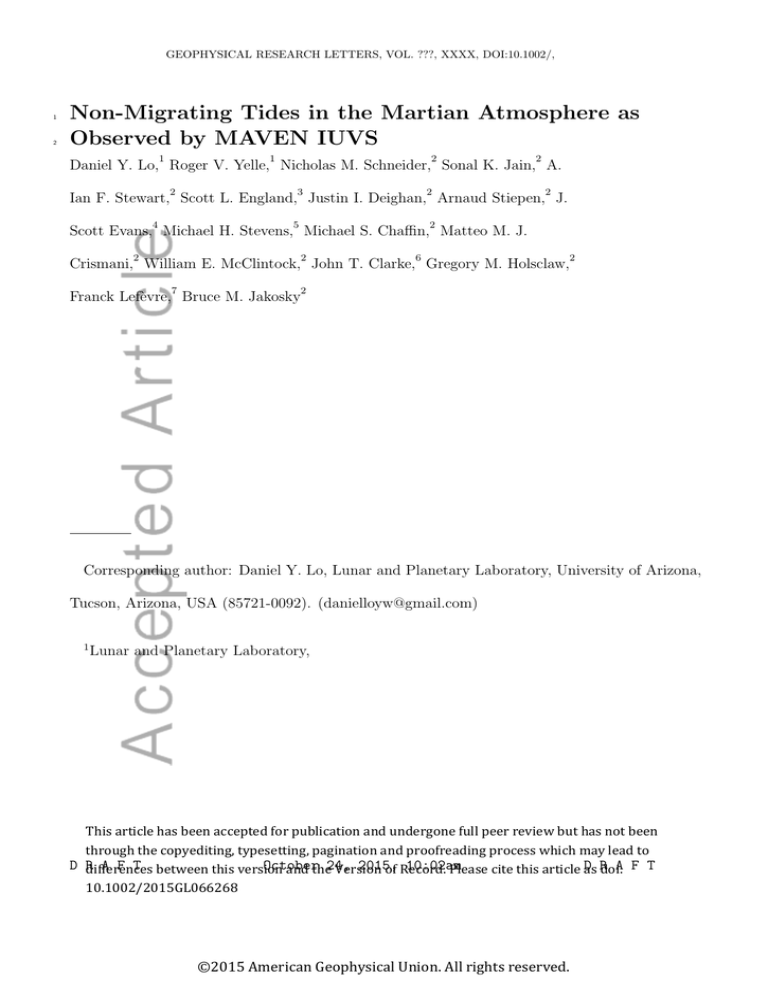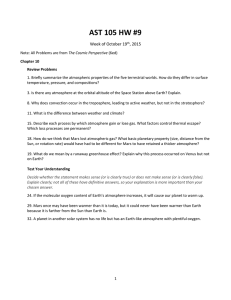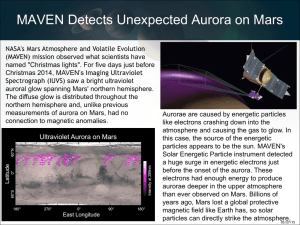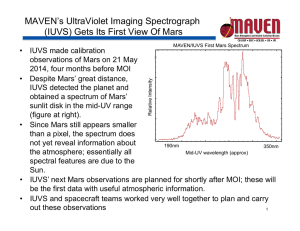
GEOPHYSICAL RESEARCH LETTERS, VOL. ???, XXXX, DOI:10.1002/,
1
2
Non-Migrating Tides in the Martian Atmosphere as
Observed by MAVEN IUVS
1
1
2
2
Daniel Y. Lo, Roger V. Yelle, Nicholas M. Schneider, Sonal K. Jain, A.
2
3
2
2
Ian F. Stewart, Scott L. England, Justin I. Deighan, Arnaud Stiepen, J.
4
5
2
Scott Evans, Michael H. Stevens, Michael S. Chaffin, Matteo M. J.
2
2
6
Crismani, William E. McClintock, John T. Clarke, Gregory M. Holsclaw,
7
Franck Lefèvre, Bruce M. Jakosky
2
2
Corresponding author: Daniel Y. Lo, Lunar and Planetary Laboratory, University of Arizona,
Tucson, Arizona, USA (85721-0092). (danielloyw@gmail.com)
1
Lunar and Planetary Laboratory,
This article has been accepted for publication and undergone full peer review but has not been
through the copyediting, typesetting, pagination and proofreading process which may lead to
D Rdifferences
A F T between this version
October
2015,
10:02am
A F T
and the24,
Version
of Record.
Please cite this article D
as R
doi:
10.1002/2015GL066268
©2015 American Geophysical Union. All rights reserved.
X -2
3
LO ET AL.: MARS ATMOSPHERIC TIDES FROM MAVEN/IUVS
Using the Mars Atmospheric and Volatile EvolutioN Mission (MAVEN)
4
Imaging Ultraviolet Spectrograph (IUVS), we found periodic longitudinal
5
variations in CO2 density in the Martian atmosphere. These density varia-
6
2 +
2
tions are derived from observations of the CO+
2 (B Σ →X Π) emission from
University of Arizona, Tucson, Arizona,
USA.
2
Laboratory for Atmospheric and Space
Physics, University of Colorado Boulder,
Boulder, Colorado, USA.
3
Space Sciences Laboratory, University of
California Berkeley, Berkeley, California,
USA.
4
Computational Physics, Inc., Springfield,
Virginia, USA.
5
Naval Research Laboratory, Washington
D. C., USA.
6
Center for Space Physics, Boston
University, Boston, Massachusetts, USA.
7
Laboratoire ATmosphères, Milieux,
Observations Spatiales, Centre National de
la Recherche Scientifique, Paris, France.
DRAFT
October 24, 2015, 10:02am
©2015 American Geophysical Union. All rights reserved.
DRAFT
X-3
LO ET AL.: MARS ATMOSPHERIC TIDES FROM MAVEN/IUVS
7
limb scans in the 100 − 190 km altitude range. The variations exhibit sig-
8
nificant structure with longitudinal wavenumbers 1, 2 and 3 in an effectively
9
constant local solar time frame, and we attribute this structure to non-migrating
10
tides. The wave-2 component is dominated by the diurnal eastward-moving
11
DE1 tide at the equator and the semidiurnal stationary S0 tide at the mid-
12
latitudes. Wave-3 is dominated by the diurnal eastward-moving DE2 tide,
13
with possibly the semidiurnal eastward-moving SE1 tide causing an ampli-
14
tude increase at the midlatitudes. Structure in the wave-1 component can
15
be explained by the semidiurnal westward-moving SW1 tide.
D R A F T
October 24, 2015, 10:02am
©2015 American Geophysical Union. All rights reserved.
D R A F T
X-4
LO ET AL.: MARS ATMOSPHERIC TIDES FROM MAVEN/IUVS
1. Introduction
16
Diurnal solar forcing of planetary atmospheres can produce tides, global-scale oscilla-
17
tions in density, pressure and temperature with periods which are harmonics of the solar
18
day. Tides have been observed throughout the atmosphere, from the equatorial region
19
[Withers et al., 2003] to the high northern and southern latitudes [Cahoy et al., 2007;
20
Withers et al., 2011], and from the surface [Wilson and Hamilton, 1996] to 160 km alti-
21
tude [Withers et al., 2003]. Numerical simulations (e.g. Forbes et al. [2002]) predict that
22
these tides can extend further up to 200 km.
23
Because of the widespread occurrence of tides, and also because tides can produce
24
significant deviations in atmospheric state variables from their equilibrium values, a com-
25
prehensive study is critical for understanding the variability of the atmosphere and the
26
circulation and transport processes that stem from this variability. Regions of turbulence
27
can form from instabilities within the tidal fields, lifting suspended dust, water vapor and
28
other atmospheric constituents into the upper atmosphere [Zurek , 1976]. By controlling
29
the densities of various atmospheric constituents directly or indirectly through such in-
30
duced transport processes, tides can strongly influence atmospheric chemistry, ultimately
31
exerting an indirect control on atmospheric loss rates. These far-reaching effects of tides
32
imply that no understanding of the atmosphere can be complete without an understanding
33
of atmospheric tides.
34
2 +
2
Using CO+
2 UV doublet (B Σ →X Π) emission profiles obtained from limb scans with
35
the Imaging Ultraviolet Spectrograph (IUVS) [McClintock et al., 2014] on board the Mars
36
Atmospheric and Volatile EvolutioN Mission (MAVEN) spacecraft [Jakosky et al., 2015],
D R A F T
October 24, 2015, 10:02am
©2015 American Geophysical Union. All rights reserved.
D R A F T
LO ET AL.: MARS ATMOSPHERIC TIDES FROM MAVEN/IUVS
X-5
37
we investigate the variation of CO2 density with latitude and longitude in a fixed local
38
solar time (LST) frame. We observe significant spatial structure in the density variations
39
and attribute this structure to tides.
40
In the next section, we provide some background information for understanding atmo-
41
spheric tides and the CO+
2 UV doublet emission. Section 3 describes the observations,
42
while Section 4 explains the steps in the processing to obtain the CO2 density. Results
43
appear in Section 5, with some discussion on the interpretation of the observed wave
44
structures. We conclude in Section 6.
2. Background
2.1. Atmospheric Tides
45
Tides describe the intrinsic oscillatory modes of the planetary atmosphere in response
46
to the diurnal solar forcing. The latitudinal and longitudinal structure of each tide is sepa-
47
rable from the vertical structure [Chapman and Lindzen, 1970; Forbes, 1995]. Altitudinal
48
dependence is described by a characteristic vertical wavelength, and evanescent modes
49
with small vertical wavelengths decay rapidly with altitude. Latitudinal variations are
50
described by Hough functions. Longitudinal variations are represented mathematically as
51
a series of cosines [Forbes et al., 2002]:
XX
s
As,n cos[(s − n)λ + nΩt + δs,n ]
(1)
n
52
where s is the zonal wavenumber, Ω is the planetary rotation rate, λ is the east longitude, t
53
is the local solar time (LST). Tides with n = 1, 2 are diurnal and semidiurnal respectively.
54
As,n and δs,n are the amplitude and phase of the individual tides, identified by the (s, n)
D R A F T
October 24, 2015, 10:02am
©2015 American Geophysical Union. All rights reserved.
D R A F T
X-6
LO ET AL.: MARS ATMOSPHERIC TIDES FROM MAVEN/IUVS
55
label [Chapman and Lindzen, 1970; Forbes, 1995]. Solar forcing on a zonally symmetric
56
planet gives rise to migrating or sun-synchronous tides, characterized by s = n. Zonal
57
asymmetries, such as in topography, surface thermal inertia, surface albedo and dust, can
58
interact with the solar forcing to produce non-migrating tides, with s 6= n [Forbes, 2004].
59
When observed in a fixed LST reference frame, longitudinal variations due to the (s, n)
60
0
that has a
tide will manifest as a wave-|s − n| structure, offset by an apparent phase δs,n
61
magnitude equal to nΩt + δs,n :
0
As,n cos[|s − n|λ + δs,n
]
(2)
62
In such a reference frame, an observer will not be able to observe variations due to mi-
63
grating tides (Equation 2 reduces to a constant over all longitudes with s = n). However,
64
this same observer will be able to observe longitudinal variations from non-migrating
65
tides, with each wave-k structure being the sum of non-migrating tides with |s − n| = k.
66
Identification of the dominant tides behind that structure involves the comparison of the
67
observed amplitudes and phases, and their dependence on latitude and altitude to model
68
results of specific tidal modes. Such is the case for this study, and we shall henceforth
69
discuss only non-migrating tides.
70
Previous observations and simulations of the Martian atmosphere have found several
71
dominant non-migrating tides. The diurnal eastward (−1, 1) tide, also referred to as DE1,
72
has been inferred from wave-2 structure in surface pressure data from Viking [Wilson and
73
Hamilton, 1996], temperature measurements in the lower atmosphere by Thermal Emis-
74
sion Spectrometer (TES) [Banfield et al., 2003; Wilson, 2000] and the middle atmosphere
D R A F T
October 24, 2015, 10:02am
©2015 American Geophysical Union. All rights reserved.
D R A F T
X-7
LO ET AL.: MARS ATMOSPHERIC TIDES FROM MAVEN/IUVS
75
by Mars Climate Sounder (MCS) [Guzewich et al., 2012], upper atmosphere densities
76
from aerobraking [Wilson, 2002; Withers et al., 2003] and atmospheric profiles inferred
77
from observations by SPectroscopy for Investigation of Characteristics of the Atmosphere
78
of Mars (SPICAM) [Withers et al., 2011]. Amplitudes are found to be ∼ 20% of the
79
equilibrium value in the upper atmosphere over the tropics and the midlatitudes, de-
80
creasing towards the poles [Withers et al., 2003, 2011]. This is consistent with numerical
81
simulations [Bougher et al., 2004; Angelats i Coll et al., 2004; Wilson, 2002; Forbes and
82
Miyahara, 2006], which returned amplitudes of 10% − 40%.
83
Wave-3 structure is typically smaller than the wave-2 component, and has been at-
84
tributed to two tides. The DE2 (−2, 1) tide has been observed in TES temperature data
85
by Wilson [2000] and Banfield et al. [2003], and in MCS data by Guzewich et al. [2012] and
86
Moudden and Forbes [2014]. Observations of atmospheric densities [Withers et al., 2003]
87
and electron densities [Bougher et al., 2001, 2004; Cahoy et al., 2007] at high latitudes
88
found the semidiurnal SE1 (−1, 2) tide to dominate instead. To reconcile the seemingly
89
contradictory conclusions from the various studies, Wilson [2002] and Withers et al. [2011]
90
suggested that DE2 is dominant at the equatorial region, while SE1 is dominant at the
91
high latitudes. This hypothesis is later confirmed by Wolkenberg and Wilson [2014].
92
The wave-1 component is typically weaker than both wave-2 and wave-3. Due to the
93
large observational uncertainties associated with lower signal strength, it has been difficult
94
attributing this component to particular tides [Withers et al., 2003, 2011]. Modeling by
95
Moudden and Forbes [2008] suggests that the diurnal stationary D0 (0, 1) tide and the
96
semidiurnal westward SW1 (1, 2) tide may be significant.
D R A F T
October 24, 2015, 10:02am
©2015 American Geophysical Union. All rights reserved.
D R A F T
X-8
LO ET AL.: MARS ATMOSPHERIC TIDES FROM MAVEN/IUVS
2.2. CO+
2 UV Doublet Emission
97
2 +
2
Often referred to as the UV doublet (UVD), the CO+
2 (B Σ →X Π) electronic transi-
98
tion system at 289 nm provides a direct measure of CO2 densities in the Martian atmo-
99
2 +
sphere. CO+
2 (B Σ ) is generated from CO2 via photoionization and photoelectron impact,
100
2
and from CO+
2 (X Π) by solar photons via fluorescent scattering [Fox , 2004]. Studies by
101
Fox and Dalgarno [1979], Jain and Bhardwaj [2012] and Stiepen et al. [2015] have found
102
photoionization and photoelectron impact to be the dominant mechanisms, with fluores-
103
cent scattering accounting for 1% of total UVD emission rates at ∼ 130 km and < 25%
104
at ∼ 180 km. This dominance of photoionization and photoelectron impact means that
105
CO+
2 UVD volume emission rates are effectively controlled by CO2 density and the solar
106
EUV flux. Since the solar EUV flux is uniform over the sunlit planetary disk, spatial
107
variations in UVD intensity can be used to infer variations in the CO2 density.
3. Observations
108
Data used in this study come from limb scans performed by the Imaging Ultraviolet
109
Spectrograph (IUVS) on the MAVEN spacecraft. Details of IUVS operation and obser-
110
vational phases can be found in McClintock et al. [2014]. Briefly, IUVS is mounted on
111
an Articulated Payload Platform (APP) which allows for controlled orientation of the
112
instrument slit as it captures spectra of the planet in the FUV (110 − 190 nm) and MUV
113
(180 − 340 nm) channels. Limb scans are taken near the periapses, with the slit pointed
114
perpendicularly and to the right of the direction of motion [Jain et al., 2015]. A scan
115
mirror sweeps the slit up and down, allowing IUVS to map the vertical profile of the
116
atmosphere with an altitude resolution of ∼ 7 km. 12 scans are taken in this manner with
D R A F T
October 24, 2015, 10:02am
©2015 American Geophysical Union. All rights reserved.
D R A F T
LO ET AL.: MARS ATMOSPHERIC TIDES FROM MAVEN/IUVS
X-9
117
each periapse pass. With the slit spanned by 7 spatial bins, a total of 84 limb profiles are
118
taken during the periapse observational phase of each orbit.
119
This study makes use of periapse limb profiles obtained with the MUV channel from
120
Orbit 109 (start time 18 October 2014 16:05 UT) to Orbit 128 (start time 22 October
121
07:49 UT), corresponding to a solar longitude Ls = 217◦ −219◦ . No data was taken during
122
Orbit 115, as the spacecraft stood down due to dust concerns associated with the passage
123
of Comet Siding Spring [Schneider et al., 2015]. In order to constrain our observations
124
to a narrow range in LST for the observation of non-migrating tides, only profiles from
125
scans 6 − 12 are used in this study. For this set of profiles, all observations are taken
126
between 1340 − 1500 LST. With each periapse pass, the tangent latitude of the line of
127
sight migrates southward from ∼ 44◦ to ∼ −5◦ while the tangent longitude varies by
128
∼ 15◦ . Spacecraft altitude increases from ∼ 190 km at scan 6 to ∼ 530 km at scan 12.
129
Between successive orbits, longitudinal coverage changes by ∼ 67◦ eastward, with every
130
16th orbit returning to approximately the same longitude. A total of 873 profiles is used
131
in our analysis.
4. Analysis
132
Raw data are processed through the standard pipeline for IUVS periapse limb scans.
133
After removing the detector dark current, the digital numbers are converted into physical
134
intensities using a calibration curve based on observations of UV-bright stars, with an
135
appropriate scaling by instrument geometric factors for extended source observations.
136
CO+
2 UVD emissions are then isolated from the calibrated spectra using a Multiple Linear
137
Regression (MLR) algorithm. The MLR algorithm involves the scaling and fitting of
D R A F T
October 24, 2015, 10:02am
©2015 American Geophysical Union. All rights reserved.
D R A F T
X - 10
LO ET AL.: MARS ATMOSPHERIC TIDES FROM MAVEN/IUVS
138
reference spectra for all known emissions in the MUV region [Stevens et al., 2015]. In the
139
289 nm region, the only significant spectral features are the UVD band and a background
140
signal that follows the spectral shape of the Sun. This latter component is still being
141
investigated but is likely due to scatter by aerosols in the Martian atmosphere, possibly
142
with an additional contribution from instrumental stray light. In either case the spectral
143
shape of the UVD and the solar component differ greatly and separation is straightforward.
144
We adopt an empirical approach to determine the CO2 density from the measured
145
intensity. The volume emission rate is parameterized as a Chapman profile and the
146
measured intensity is fitted to the integral of the volume emission rate along the line of
147
sight:
I=2
Z ∞
b
z0 − z σn0 H (z0 −z)/H
Cσn0 exp
−
e
H
µ0
!
rdz
√
r 2 − b2
148
where z is the altitude, b is the impact parameter measured from the center of the planet,
149
r = R + z with R being the planetary radius, σ is the absorption cross-section for the UV
150
photon, n0 is the number density of CO2 at the reference altitude z0 , H is the atmospheric
151
scale height, µ0 is the cosine of the solar zenith angle, and C is a proportionality factor
152
that accounts for the solar flux and any calibration factors. z0 is set to be 130 km for
153
ease of comparison with other studies of Martian atmospheric tides. Three parameters
154
are allowed to vary in the fitting process: C, H, and σn0 , which we refer to as the scaled
155
density. Because the fit is done over an altitude range of 100 − 190 km, it will be more
156
sensitive to tides with long vertical wavelengths that span a larger fraction of that window.
157
Figure 1 shows some fits to the MLR-derived profiles.
D R A F T
October 24, 2015, 10:02am
©2015 American Geophysical Union. All rights reserved.
D R A F T
LO ET AL.: MARS ATMOSPHERIC TIDES FROM MAVEN/IUVS
X - 11
158
Of course, we do not expect the volume emission rate to rigorously follow a Chapman
159
profile. The Chapman layer is used here as a convenient way to empirically characterize
160
the emissions rather than a rigorous description of the excitation process. Nonetheless,
161
because the Chapman layer is an approximation to the UVD emission processes, its emis-
162
sion profile possesses the correct shape and, as shown in Figure 1, the fits based on this
163
approach are excellent. The analytic form of this Chapman approximation allows us to
164
easily determine the value of σn◦ for characterizing CO2 density variations in the at-
165
mosphere. As the fits in Figure 1 show, the scaled density controls the altitude of the
166
emission peak, essentially the altitude of the maximum CO2 photoionization rate. The
167
Chapman profile does rigorously describe the variation of emission rate with solar zenith
168
angle to the extent that the atmosphere can be treated as plane-parallel. Thus it satisfies
169
our objective in providing a good measure of the relative CO2 density variations in the
170
atmosphere. In addition, the derived scaled densities will not be sensitive to the detector
171
calibration. Although there are uncorrected flatfield effects that result in sensitivity vari-
172
ations of ∼ 10% across the spatial bins, these will only change the value of C rather than
173
the scaled density.
5. Results and Discussion
174
Figure 2 shows an overview of variations in CO2 density with latitude and longitude.
175
Because IUVS coverage returns to a similar longitude every 16th orbit, we are able to
176
determine these variations to be persistent in a fixed LST frame, leading to our interpre-
177
tation of the observed structures as tides. Along the equator, we observe a strong wave-2
178
tidal component, with peaks occurring at 75◦ E and 225◦ E. The amplitude of this compo-
D R A F T
October 24, 2015, 10:02am
©2015 American Geophysical Union. All rights reserved.
D R A F T
X - 12
LO ET AL.: MARS ATMOSPHERIC TIDES FROM MAVEN/IUVS
179
nent decreases towards higher latitude. There is also a smaller set of peaks at ∼ 40◦ N, at
180
a different apparent phase from the equatorial component.
181
As discussed previously, identification of the dominant tides requires the decomposition
182
of the structure into components of different wavenumbers, and subsequent analysis of
183
the amplitudes and phases. Grouping profiles into 10◦ latitude bands, we fit sinusoids
184
of wavenumber 1, 2 and 3 to the scaled density values. Figure 3 shows the fits between
185
−5◦ N and 5◦ N and between 35◦ N and 45◦ N. Figure 4 shows the amplitudes A0 normalized
186
to the equilibrium values and apparent phases δ 0 from the fits, with Table 1 showing the
187
plotted values.
188
As anticipated from Figure 2, the wave-2 component has the largest average amplitude,
189
with a peak of 29% at ∼ 10◦ N, decreasing to 6% at ∼ 30◦ N. This structure is characteristic
190
of the DE1 tide which has been identified as the dominant mode at the equatorial region
191
by the previous studies detailed in Section 2.1. Further confirmation of a dominant DE1
192
tide comes from the phase, which has been found to change minimally with season from
193
the surface to 130 km [Wilson, 2002]. After correcting for the LST, we find a phase of
194
253 ± 7◦ at the equator, comparable to the phase of 286 ± 20◦ (averaged over −5◦ N and
195
5◦ N) observed by Withers et al. [2003]. Northwards of ∼ 30◦ N, the amplitude increases
196
slightly to 8%, with a significant decrease in apparent phase. This change in apparent
197
phase, together with the amplitude trending in the opposite direction expected from the
198
DE1 tide, suggest another tide becoming dominant at the higher latitudes. Modeling by
199
Moudden and Forbes [2008] found the semidiurnal stationary S0 (0, 2) tide increasing to
200
20% of the DE1 peak amplitude at ∼ 40◦ N, consistent with our observations. If we assume
D R A F T
October 24, 2015, 10:02am
©2015 American Geophysical Union. All rights reserved.
D R A F T
LO ET AL.: MARS ATMOSPHERIC TIDES FROM MAVEN/IUVS
X - 13
201
that these model results remain valid over different seasons (Ls = 26◦ − 92◦ for Moudden
202
and Forbes [2008]), then the amplitude increase in the wave-2 component at the higher
203
latitudes can be explained by the S0 tide.
204
The average amplitude of the wave-3 component is slightly smaller than that for wave-
205
2, decreasing from 18% from the equator with latitude. This latitudinal structure agrees
206
well with previous studies such as Bougher et al. [2001], Bougher et al. [2004], Withers
207
et al. [2003] and Withers et al. [2011], and points to the DE2 tide, rather than SE1
208
which instead has a local maximum at ∼ 20◦ N. This is consistent with the observations
209
by Wilson [2002] and Withers et al. [2011] that DE2 dominates at equatorial latitudes.
210
Phases show only a rough correspondence however, with values of 25 ± 7◦ , 54 ± 9◦ and
211
∼ 90◦ for this study, Withers et al. [2003] and Wilson [2002] respectively. This discrepancy
212
in phase may be due to the different seasons at which the observations for the various
213
studies were conducted. At 30◦ − 40◦ N, a reversal in the amplitude trend expected from
214
DE2 together with a large change in apparent phase of 200◦ (almost a flip in the tidal
215
structure) point to the presence of another dominant tide at the higher latitudes. The
216
amplitude increase is consistent with SE1 becoming dominant at the higher latitudes, but
217
a poor correspondence in phases and the constraint of observations to a single LST in this
218
study prevent a conclusive identification.
219
While previous observational studies have detected a weak but significant wave-1 com-
220
ponent, these studies were unable to pinpoint the dominant tides producing this wave-1
221
signal. Our fitted wave-1 component exhibits a sharp peak at ∼ 20◦ N, which resembles
222
the structure for the SW1 (1, 2) tide as modeled by Moudden and Forbes [2008]. Beneath
D R A F T
October 24, 2015, 10:02am
©2015 American Geophysical Union. All rights reserved.
D R A F T
X - 14
LO ET AL.: MARS ATMOSPHERIC TIDES FROM MAVEN/IUVS
223
the peak, the observed amplitude also shows a general decrease towards the north, another
224
feature consistent with the modeled SW1 tide. With the same caveat regarding poten-
225
tially unknown seasonal dependences, we suggest that the wave-1 structure is dominated
226
by the SW1 tide.
6. Conclusions
227
Examining variations in CO2 scaled densities derived from fitting Chapman profiles to
228
CO+
2 UVD emissions from IUVS limb scans, we are able to observe significant wave-1,
229
wave-2 and wave-3 tidal structure at 100 − 190 km altitude. Amplitudes of all three
230
components are consistent with previous observations and modeling results. Wave-2 is
231
dominated by DE1 at the equator, with S0 being a possible explanation for the struc-
232
ture observed at the midlatitudes. Wave-3 structure is consistent with DE2 and SE1
233
at the equator and midlatitudes respectively, but this cannot be confirmed by a phase
234
comparison. Wave-1 appears to be dominated by SW1.
235
Generally, identification of tides in this study is complicated by an uncertainty that
236
stems from a poor understanding of how tides in the upper Martian atmosphere change
237
with the seasons. This uncertainty should not persist for long however. The dataset
238
used in this study is but a small fraction of all limb scan data that will come from
239
MAVEN IUVS. This study demonstrates that even with a limited dataset we are able
240
to draw significant conclusions, and is a prelude to the science that can come from an
241
expanding dataset as MAVEN proceeds through its mission. We will be able to investigate
242
seasonal changes in the tidal structures, and also better characterize the vertical structure
243
of tides with the larger volume of data. The precession of the spacecraft orbit will allow
D R A F T
October 24, 2015, 10:02am
©2015 American Geophysical Union. All rights reserved.
D R A F T
LO ET AL.: MARS ATMOSPHERIC TIDES FROM MAVEN/IUVS
X - 15
244
us to sample densities at a different LST, to better characterize phases of the various
245
tides, and to go beyond the restrictions of the constant LST frame and start observing
246
migrating tides. These additional dimensions to the data will be able to provide more
247
constraints for the validation of atmospheric models, ultimately forming the foundation
248
for the comprehensive study we need to understand the behavior and effects of thermal
249
tides in the Martian atmosphere.
250
Acknowledgments. The data used in the study are archived in the Planetary Atmo-
251
spheres Node of the Planetary Data System at http://atmos.nmsu.edu/data and services/atmospheres data
252
Each filename is marked with the identifier “periapse”, the orbit number, the start time of
253
the observation, and “v02 r01” reflecting the version of the calibration curve and MLR de-
254
composition. The MAVEN project is supported by NASA through the Mars Exploration
255
Program. Arnaud Stiepen is supported by the Belgian American Educational Foundation
256
and the Rotary District 1630. The authors thank Steve Bougher, John Wilson and Paul
257
Withers for providing critical and valuable comments towards the improvement of this
258
manuscript in their reviews.
References
259
Angelats i Coll, M., F. Forget, M. A. Lopez-Valverde, P. L. Read, and S. R. Lewis (2004),
260
Upper atmosphere of Mars up to 120 km: Mars Global Surveyor accelerometer data
261
analysis with the LMD general circulation model, Journal of Geophysical Research, 109,
262
E01011, doi:10.1029/2003JE002163.
D R A F T
October 24, 2015, 10:02am
©2015 American Geophysical Union. All rights reserved.
D R A F T
X - 16
LO ET AL.: MARS ATMOSPHERIC TIDES FROM MAVEN/IUVS
263
Banfield, D., B. J. Conrath, M. D. Smith, P. R. Christensen, and R. J. Wilson (2003),
264
Forced waves in the Martian atmosphere from MGS TES nadir data, Icarus, 161, 319–
265
345, doi:10.1016/j.icarus.2004.03.015.
266
Bougher, S. W., S. Engel, D. P. Hinson, and J. M. Forbes (2001), Mars Global Surveyor
267
Radio Science electron density profiles: Neutral atmosphere implications, Geophysical
268
Research Letters, 28 (16), 3091–3094.
269
Bougher, S. W., S. Engel, D. P. Hinson, and J. R. Murphy (2004), MGS Radio Science elec-
270
tron density profiles: Interannual variability and implications for the Martian neutral
271
atmosphere, Journal of Geophysical Research, 109, E03010, doi:10.1029/2003JE002154.
272
Cahoy, K. L., D. P. Hinson, and G. L. Tyler (2007), Characterization of a semidi-
273
urnal eastward-propagating tide at high northern latitudes with Mars Global Sur-
274
veyor electron density profiles, Geophysical Research Letters, 34, L15201, doi:
275
10.1029/2007GL030449.
276
277
278
279
280
281
Chapman, S., and R. Lindzen (1970), Atmospheric tides. Thermal and gravitational, D.
Reidel, Dordrecht, Netherlands.
Forbes, J. M. (1995), Tidal and planetary waves, 67–87 pp., American Geophysical Union,
Washington, D. C., doi:10.1029/GM087p0067.
Forbes, J. M. (2004), Tides in the middle and upper atmospheres of Mars and Venus,
Advances in Space Research, 33 (2), 125–131, doi:10.1016/j.asr.2003.05.007.
282
Forbes, J. M., and S. Miyahara (2006), Solar semidiurnal tide in the dusty atmosphere of
283
Mars, Journal of the Atmospheric Sciences, 63 (7), 1798–1817, doi:10.1175/JAS3718.1.
D R A F T
October 24, 2015, 10:02am
©2015 American Geophysical Union. All rights reserved.
D R A F T
X - 17
LO ET AL.: MARS ATMOSPHERIC TIDES FROM MAVEN/IUVS
284
Forbes, J. M., F. C. Bridger, Alison, S. W. Bougher, M. E. Hagan, J. L. Hollingsworth,
285
G. M. Keating, and J. Murphy (2002), Nonmigrating tides in the thermosphere of Mars,
286
Journal of Geophysical Research, 107 (E11), 5113, doi:10.1029/2001JE001582.
287
Forget, F., F. Montmessin, J.-L. Bertaux, F. González-Galindo, S. Lebonnois,
288
E. Quémerais, A. Reberac, E. Dimarellis, and M. A. López-Valverde (2009), Density
289
and temperatures of the upper Martian atmosphere measured by stellar occultations
290
with Mars Express SPICAM, Journal of Geophysical Research: Planets, 114, E01,004,
291
doi:10.1029/2008JE003086.
292
Fox, J. L. (2004), CO+
2 dissociative recombination: A source of thermal and nonthermal
293
C on Mars, Journal of Geophysical Research, 109, A08,306, doi:10.1029/2004JA010514.
294
Fox, J. L., and A. Dalgarno (1979), Ionization, luminosity, and heating of the up-
295
per atmosphere of Mars, Journal of Geophysical Research, 86 (A12), 7315–7333, doi:
296
10.1029/JA086iA02p00629.
297
Guzewich, S. D., and E. R. Talaat, and D. W Waugh (2012), Observations of planetary
298
waves and nonmigrating tides by the Mars Climate Sounder, Journal of Geophysical
299
Research: Planets, 117, E03010, doi:10.1029/2011JE003924.
300
Jakosky, B. M., R. P. Lin, J. M. Grebowsky, J. G. Luhmann, D. F. Mitchell, G. Beu-
301
telschies, T. Priser, M. Acuna, L. Andersson, D. Baird, D. Baker, R. Bartlett, M. Benna,
302
S. Bougher, D. Brain, D. Carson, S. Cauffman, P. Chamberlin, J.-Y. Chaufray,
303
O. Cheatom, J. Clarke, J. Connerney, T. Cravens, D. Curtis, G. Delory, S. Demcak,
304
A. DeWolfe, F. Eparvier, R. Ergun, A. Eriksson, J. Espley, X. Fang, D. Folta, J. Fox,
305
C. Gomez-Rosa, S. Habenicht, J. Halekas, G. Holsclaw, M. Houghton, R. Howard,
D R A F T
October 24, 2015, 10:02am
©2015 American Geophysical Union. All rights reserved.
D R A F T
X - 18
LO ET AL.: MARS ATMOSPHERIC TIDES FROM MAVEN/IUVS
306
M. Jarosz, N. Jedrich, M. Johnson, W. Kasprzak, M. Kelley, T. King, M. Lankton,
307
D. Larson, F. Leblanc, F. Lefevre, R. Lillis, P. Mahaffy, C. Mazelle, W. McClintock,
308
J. McFadden, D. L. Mitchell, F. Montmessin, J. Morrissey, W. Peterson, W. Possel,
309
J.-A. Sauvaud, N. Schneider, W. Sidney, S. Sparacino, A. I. F. Stewart, R. Tolson,
310
D. Toublanc, C. Waters, T. Woods, R. Yelle, R. Zurek (2015), The Mars Atmosphere
311
and Volatile Evolution (MAVEN) Mission, Space Science Reviews, doi:10.1007/s11214-
312
015-0139-x.
313
Jain, S. K., and A. Bhardwaj (2011), Model calculation of N2 Vegard-Kaplan band emis-
314
sions in Martian dayglow, Journal of Geophysical Research: Planets, 116, E07005, doi:
315
10.1029/2010JE003778.
316
Jain, S. K., and A. Bhardwaj (2012), Impact of solar EUV flux on CO Cameron band
317
and CO+
2 UV doublet emissions in the dayglow of Mars, Planetary and Space Science,
318
63-64, 110–122, doi:10.1016/j.pss.2011.08.010.
319
Jain, S. K., A. I. F. Stewart, N. M. Schneider, J. I. Deighan, A. Stiepen, J. S. Evans,
320
M. H. Stevens, M. S. Chaffin, W. E. McClintock, J. T. Clarke, G. M. Holsclaw,
321
B. M. Jakosky (2015), The structure and variability of Mars upper atmosphere as
322
seen in MAVEN/IUVS dayglow observations, Geophysical Research Letters, 42, doi:
323
10.1002/2015GL065419.
324
Lee, C., W. G. Lawson, M. I. Richardson, N. G. Heavens, A. Kleinbohl, D. Banfield,
325
D. J. McCleese, R. W. Zurek, D. Kass, J. T. Schofield, C. B. Leovy, F. W. Taylor,
326
and A. D. Toigo. (2009), Thermal tides in the Martian middle atmosphere as seen by
327
the Mars Climate Sounder, Journal of Geophysical Research: Planets, 114, E03005,
D R A F T
October 24, 2015, 10:02am
©2015 American Geophysical Union. All rights reserved.
D R A F T
X - 19
LO ET AL.: MARS ATMOSPHERIC TIDES FROM MAVEN/IUVS
328
doi:10.1029/2008JE003285.
329
McClintock, W. E., N. M. Schneider, G. M. Holsclaw, J. T. Clarke, A. C. Hoskins,
330
A. I. Stewart, F. Montmessin, R. V. Yelle, and J. Deighan (2014), The Imaging Ul-
331
traviolet Spectrograph (IUVS) for the MAVEN Mission, Space Science Reviews, doi:
332
10.1007/s11214-014-0098-7.
333
Moudden, Y., and J. M. Forbes (2008), Topographic connections with density waves in
334
Mars’ aerobraking regime, Journal of Geophysical Research: Planets, 113, E11009, doi:
335
10.1029/2008JE003107.
336
Moudden, Y., and J. M. Forbes (2014), Insight into the seasonal asymmetry of
337
nonmigrating tides on Mars, Geophysical Research Letters, 41, 2631–2636, doi:
338
10.1029/2008JE003107.
339
340
Schunk, R., and A. Nagy (2009), Ionospheres: Physics, plasma physics, and chemistry,
Cambridge University Press, Cambridge, UK.
341
Schneider, N. M., J. I. Deighan, A. I. F. Stewart, W. E. McClintock, S. K. Jain, M. S. Chaf-
342
fin, A. Stiepen, M. Crismani, J. M. C. Plane, J. D. Carrillo-Sanchez, J. S. Evans,
343
M. H. Stevens, R. V. Yelle, J. T. Clarke, G. M. Holsclaw, F. Montmessin, B. M. Jakosky
344
(2015), MAVEN IUVS observations of the aftermath of the Comet Siding Spring meteor
345
shower on Mars, Geophysical Research Letters, 42, doi:10.1002/2015GL063863.
346
Stevens, M. H., J. S. Evans, N. M. Schneider, A. I. F. Stewart, J. Deighan, S. K. Jain,
347
W. E. McClintock, G. M. Holsclaw, J. T. Clarke and B. M. Jakosky (2015), New obser-
348
vations of molecular nitrogen in the Martian upper atmosphere by IUVS on MAVEN,
349
Geophysical Research Letters, 42, doi:10.1002/2015GL065319.
D R A F T
October 24, 2015, 10:02am
©2015 American Geophysical Union. All rights reserved.
D R A F T
X - 20
LO ET AL.: MARS ATMOSPHERIC TIDES FROM MAVEN/IUVS
350
Stiepen, A., Gerard, J.-C., Bougher, S. W., Montmessin, F., Hubert, B., Bertaux, J.-L.
351
(2015), Mars thermospheric scale height: CO Cameron and CO+
2 dayglow observations
352
from Mars Express, Icarus, 245, 295–305, doi:10.1016/j.icarus.2014.09.051.
353
Wilson, R. J. (2002), Evidence for diurnal period Kelvin waves in the Martian Atmosphere
354
from Mars Global Surveyor TES data, Geophysical Research Letters, 27 (23), 3889–3892,
355
doi:10.1029/2000GL012028.
356
Wilson, R. J. (2002), Evidence for nonmigrating thermal tides in the Mars upper atmo-
357
sphere from the Mars Global Surveyor Accelerometer Experiment, Geophysical Research
358
Letters, 29 (7), 1120–1123, doi:10.1029/2001GL013975.
359
Wilson, R. J., and K. Hamilton (1996), Comprehensive model simulation of thermal tides
360
in the Martian atmosphere, Journal of the Atmospheric Sciences, 53 (9), 1290–1326,
361
doi:10.1175/1520-0469(1996)053<1290:CMSOTT>2.0.CO;2.
362
Withers, P., S. W. Bougher, and G. M. Keating (2003), The effects of topographically-
363
controlled thermal tides in the martian upper atmosphere as seen by the MGS ac-
364
celerometer, Icarus, 164, 14–32, doi:10.1016/S0019-1035(03)00135-0.
365
Withers, P., R. Pratt, J.-L. Bertaux, and F. Montmessin (2011), Observations of ther-
366
mal tides in the middle atmosphere of Mars by the SPICAM instrument, Journal of
367
Geophysical Research: Planets, 116, E11,005, doi:10.1029/2011JE003847.
368
Wolkenberg, P., and R. J. Wilson (2014), Mars Climate Sounder observations of wave
369
structure in the north polar middle atmosphere of Mars during the summer season,
370
Eighth International Conference on Mars, Pasadena, CA, Abstract 1219.
D R A F T
October 24, 2015, 10:02am
©2015 American Geophysical Union. All rights reserved.
D R A F T
X - 21
LO ET AL.: MARS ATMOSPHERIC TIDES FROM MAVEN/IUVS
371
372
373
374
Zurek, R. W. (1976), Diurnal tide in the Martian atmosphere, Journal of the Atmospheric
Sciences, 33 (2), 321–337, doi:10.1175/1520-0469(1976)033<0321:DTITMA>2.0.CO;2.
Zurek, R. W. (1988), Free and forced modes in the Martian atmosphere, Journal of
Geophysical Research, 93 (D8), 9452–9462, doi:10.1029/JD093iD08p09452.
D R A F T
October 24, 2015, 10:02am
©2015 American Geophysical Union. All rights reserved.
D R A F T
X - 22
LO ET AL.: MARS ATMOSPHERIC TIDES FROM MAVEN/IUVS
sampleProfile.pdf
◦
Figure 1. Chapman layer fits to isolated CO+
2 UVD profiles at ∼ 10 N and different longitudes.
All profiles are from scan 10 spatial bin 4 of the respective orbits. Error bars denote 1σ random
uncertainties in the measurements. The higher density at 221◦ E gives rise to a higher altitude of
the emission peak (indicated by the arrows).
Table 1.
Fitted amplitudes A0k normalized to zonal mean and apparent phases δk0 for various
latitude bands for wavenumbers k = 1, 2, 3.
Latitude
−5◦ N to 5◦ N
5◦ N to 15◦ N
15◦ N to 25◦ N
25◦ N to 35◦ N
35◦ N to 45◦ N
Tides Identified
D R A F T
A01
δ10
◦
13% ± 2% 263 ± 10◦
11% ± 2% 233◦ ± 13◦
19% ± 3% 289◦ ± 7◦
7% ± 2% 320◦ ± 17◦
4% ± 1% 150◦ ± 21◦
SW1
δ20
A02
◦
20% ± 2% 253 ± 6◦
29% ± 2% 237◦ ± 4◦
16% ± 2% 230◦ ± 9◦
7% ± 2% 169◦ ± 14◦
8% ± 2% 143◦ ± 10◦
DE1, S0
A03
17% ± 3%
16% ± 2%
9% ± 2%
7% ± 2%
8% ± 2%
DE2,
October 24, 2015, 10:02am
©2015 American Geophysical Union. All rights reserved.
δ30
121 ± 6◦
101◦ ± 6◦
92◦ ± 15◦
296◦ ± 15◦
344◦ ± 11◦
SE1
◦
D R A F T
LO ET AL.: MARS ATMOSPHERIC TIDES FROM MAVEN/IUVS
X - 23
tides.pdf
Figure 2.
Scaled density at 130 km binned by latitude and longitude, with crosses showing
the location of the individual profiles. Observations are made between 1340 − 1500 LST at
Ls = 217◦ − 219◦ . A value of 0.1 (km−1 ) corresponds to a density of ∼ 1011 cm−3 assuming
σ ∼ 10−17 cm2 .
D R A F T
October 24, 2015, 10:02am
©2015 American Geophysical Union. All rights reserved.
D R A F T
X - 24
LO ET AL.: MARS ATMOSPHERIC TIDES FROM MAVEN/IUVS
fitplots.pdf
Figure 3.
Fit to variations of scaled density at 130 km derived from profiles from −5◦ N to
5◦ N (left) and from 35◦ N to 45◦ N (right). Error bars denote 1σ fit uncertainties. A value of 0.1
(km−1 ) in scaled density corresponds to a density of ∼ 1011 cm−3 assuming σ ∼ 10−17 cm2 .
D R A F T
October 24, 2015, 10:02am
©2015 American Geophysical Union. All rights reserved.
D R A F T
LO ET AL.: MARS ATMOSPHERIC TIDES FROM MAVEN/IUVS
X - 25
fit.pdf
Figure 4. Fitted amplitudes A0 and apparent phases δ 0 for wave-1, wave-2 and wave-3 components for scaled densities at 130 km obtained from profiles grouped by latitude band. Error bars
denote 1σ fit uncertainties.
D R A F T
October 24, 2015, 10:02am
©2015 American Geophysical Union. All rights reserved.
D R A F T
©2015 American Geophysical Union. All rights reserved.
©2015 American Geophysical Union. All rights reserved.
©2015 American Geophysical Union. All rights reserved.
©2015 American Geophysical Union. All rights reserved.









